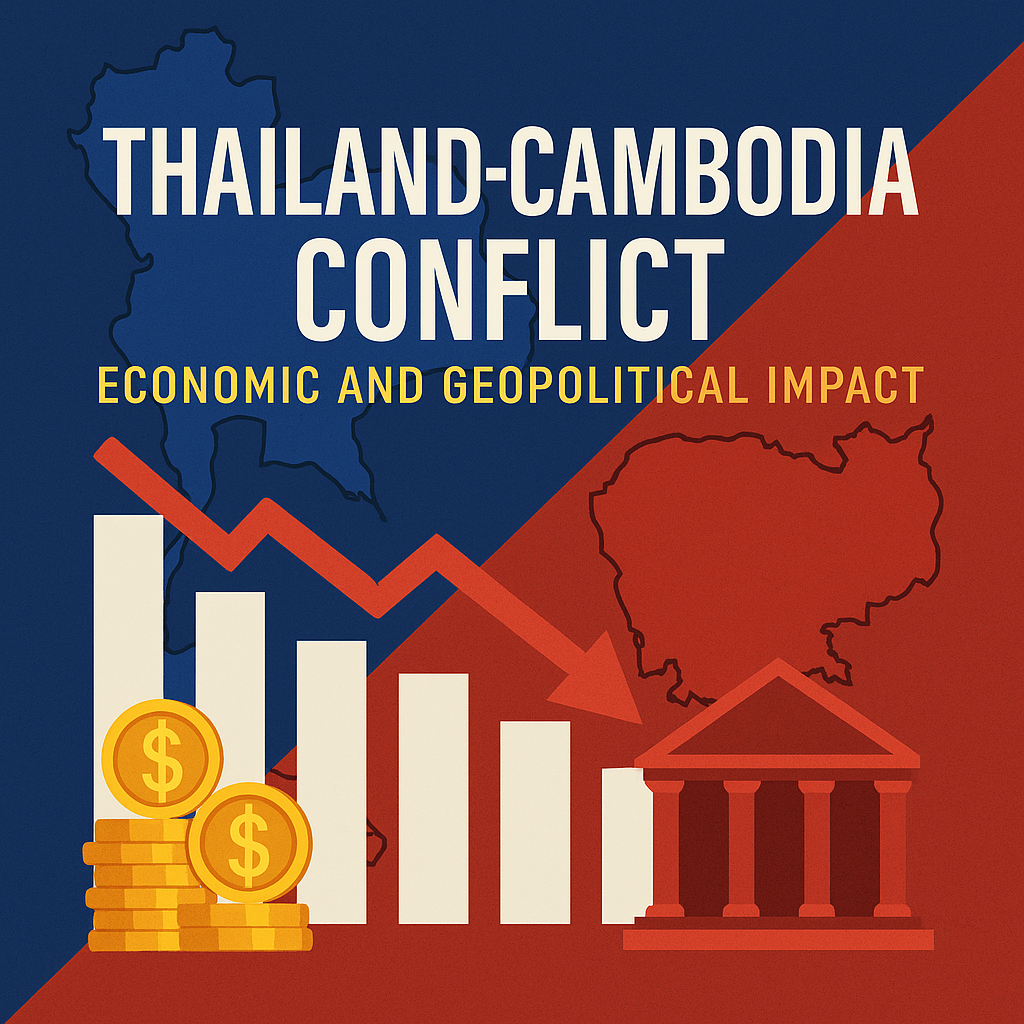As border tensions between Thailand and Cambodia escalated in mid-2025, most headlines focused on military clashes and political fallout. But beneath the smoke of artillery and the flash of diplomatic spats, a deeper crisis has quietly unfolded—an economic one. The financial implications of the border conflict are not just collateral damage; they are front and center in shaping the region’s stability.
When Borders Close, Economies Freeze
One of the most immediate effects of the conflict has been the closure of all land border checkpoints. This move has effectively frozen a cross-border trade corridor worth over 174 billion baht annually. According to The Nation, these closures have led to daily trade losses of around 500 million baht, impacting everything from agricultural exports to logistics operations.
In response, Cambodia has retaliated by banning Thai imports of fuel, electricity, food products, and even media content. As reported by Cambodge Mag, this has caused shortages and price spikes in Cambodian provinces, while Thai vendors, particularly in border towns like Aranyaprathet, are facing massive revenue slumps and inventory pileups.
Tourism: A Fragile Recovery Undone
Tourism, which contributes roughly 12% of Thailand’s GDP and 9% of Cambodia’s, is also feeling the shock. The rise in violence has discouraged regional travelers and prompted widespread booking cancellations. According to CNBC, Cambodia is especially vulnerable, with Thai tourists historically making up a significant portion of its annual visitors.
The psychological ripple of border skirmishes is felt even in non-affected areas. In The Guardian, Thai evacuees describe the fear that now shadows daily life. With more than 130,000 civilians displaced, local hospitality businesses have seen visitor numbers collapse. Cambodian workers returning home from Thailand due to insecurity are further straining local labor markets.
Market Tremors and Capital Flight
Financial markets have responded as expected—with anxiety. The Stock Exchange of Thailand (SET) dropped nearly 4.8% between May and July, driven by investor concerns over political instability and trade disruption. A detailed analysis from The Pechko Perspective warns that parallels can be drawn with past crises that triggered prolonged capital flight and reduced foreign direct investment.
Meanwhile, the Cambodia Securities Exchange (CSX) has shed approximately 12% of its market value, driven by energy insecurity and declining tourism earnings. According to AINVEST, Cambodian equities have seen reduced foreign investor participation amid fears of prolonged instability.
Defense and Energy: Where the Money Goes
Ironically, one of the few sectors seeing a boost is defence. With both governments increasing military spending by roughly 20% year-on-year, companies like Thai Aerospace Industries and Siam Defense Systems are experiencing rising demand. As noted by AINVEST, these firms have outperformed the broader market, making them unexpected winners in a time of conflict.
Cambodia’s energy insecurity is also reshaping regional energy flows. With Thailand halting fuel exports—previously covering up to 30% of Cambodia’s demand—Cambodia has turned to Vietnam and Singapore for new supply chains. This pivot benefits state-owned firms like PetroVietnam and Petronas, which are now expanding their regional footprint.
Government Response and Fiscal Buffering
On July 25, Thailand’s cabinet approved a relief package targeting border communities, small businesses, and affected farmers. The Nation reports that the program includes low-interest loans, debt suspension, and government-backed guarantees. Banks such as GSB and Kasikornbank have activated emergency protocols to support SMEs and individual borrowers impacted by the crisis.
Cambodia, facing slower economic growth projections, is lobbying for international support while pushing its territorial claims to the International Court of Justice (ICJ). Thailand, however, insists on resolving disputes via the Joint Boundary Commission (JBC), rejecting third-party arbitration—a disagreement that is prolonging uncertainty for investors (Cambodge Mag).
A Regional Wake-Up Call
For ASEAN, the Thailand–Cambodia crisis presents a sobering challenge. The long-touted vision of a unified Southeast Asian market now faces a credibility test. Trade corridors have proven fragile under fire, and political trust among member states is fraying. As noted by DW, local communities are increasingly sceptical of diplomatic mechanisms that fail to protect their livelihoods.
As TIME Magazine observed, the crisis reflects more than old territorial disputes. It’s also a reflection of political ego, posturing, and a struggle for influence between powerful families on both sides of the border. And while leaders play a game of geopolitical chess, ordinary people—and the region’s economies—pay the price.
Conclusion: Peace as a Profitable Investment
This conflict is a reminder that in today’s interconnected world, war is not just waged on battlefields—it’s waged on balance sheets, supply chains, and consumer confidence. The longer the crisis lasts, the deeper the economic scars will grow, not just in Thailand and Cambodia, but across Southeast Asia.
Markets crave one thing above all: certainty. And in a region that has worked hard to project stability and economic promise, this crisis underscores how quickly trust—and capital—can vanish when peace is no longer assured.
